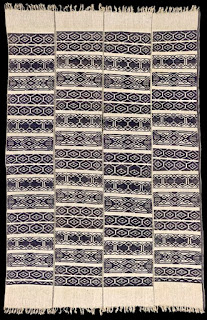Aso Olona: Production and trade in the Niger Delta

The Aso Olona clothes of the Ijebu Yoruba are one of the most renowned Yoruba women's weaving traditions. These beautiful complex patterned textiles were not only created for use by the Ogboni Elder society ( called Oshugbo in Ijebu) but were important markers of chieftaincy and valued trade items exported to other communities both within and outside of Yorubaland. (Above)Indigo and White Aso Olona cloth Aso Olona (Cloth with patterns, Literally cloth that possesses art) is one of many diverse area-specific textiles made using the upright continuous warp loom. The cloth is most noted as part of the regalia of the Oshugbo elder society. This initiation society is closely associated with the worship of the earth goddess Ile. Through their connection with Ile, who is the arbiter of both life and death, it is Ogboni/Oshugbo that facilitates, orders, and permits the spilling of human blood, in adition to rites and rituals deeply tied to royal authority. The symbolism of Aso Olon...

